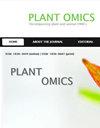MtNOOT gene enhanced high productivity and economical characteristics of tomato (Lycopersicon esculentum)
Q3 Agricultural and Biological Sciences
引用次数: 0
Abstract
Tomato (Lycopersicon esculentum) is the main vegetal crop that has tremendous popularity around the world. Medicago truncatula NOOT gene (Mt-NOOT) encodes a BTB/POZ-ankyrin repeat protein of the NONEXPRESSOR OF PR GENES1 (NPR1 family). It was introduced into Lycopersicon esculentum (Tomato) genome. The tomato plants that ectopically expressed Mt-NOOT obtained several favorable traits and fruit quality. Heteroblasty between the transgenic and the non-transgenic tomato leaves and flower architecture were used to distinguish transgenic and wild lines. Transgenic tomato plants accumulated a significant amount of phenolic compounds and plant pigmentations compared to the wild type. On the other hand, transgenic plants acquired a considerable amount of antioxidant such as CuZnSO superoxide dismutase (SOD), tomato Catalase (CAT), and tomato Cell wall-associated peroxidase (TPX1) than the wild type. Antioxidant high content together with the high content of phenolic compounds enabled the transgenic tomato fruits to gain not only edible benefits, but also a significant higher shelf-time, extended to six months more than the wild type stored at 25°C in dark and dry condition. Surprisingly, transgenic tomato fruits did not show any rotten process during long time storage as they did not acquire any contagious microorganism. Total fruit productivity in transgenic tomato was greater than the control with an estimated ratio of 84%.MtNOOT基因提高番茄的高产率和经济性状
番茄(Lycopersicon esculentum)是主要的植物作物,在世界各地都非常受欢迎。截茎苜蓿NOOT基因(Mt NOOT)编码PR基因1(NPR1家族)无表达子的BTB/POZ锚蛋白重复序列蛋白。将其引入番茄基因组中。外源表达Mt NOOT的番茄植株获得了一些有利的性状和果实品质。利用转基因番茄与非转基因番茄的叶片和花结构的杂种性来区分转基因番茄与野生番茄。与野生型相比,转基因番茄植物积累了大量的酚类化合物和植物色素。另一方面,转基因植物比野生型获得了大量的抗氧化剂,如CuZnSO超氧化物歧化酶(SOD)、番茄过氧化氢酶(CAT)和番茄细胞壁相关过氧化物酶(TPX1)。抗氧化剂的高含量和酚类化合物的高含量使转基因番茄果实不仅获得了可食用的好处,而且具有显著更高的保质期,比野生型在25°C的黑暗干燥条件下储存多6个月。令人惊讶的是,转基因番茄果实在长时间储存过程中没有表现出任何腐烂过程,因为它们没有获得任何传染性微生物。转基因番茄的果实总产量高于对照,估计比例为84%。
本文章由计算机程序翻译,如有差异,请以英文原文为准。
求助全文
约1分钟内获得全文
求助全文
来源期刊

Plant Omics
生物-植物科学
CiteScore
1.30
自引率
0.00%
发文量
0
审稿时长
6 months
期刊介绍:
Plant OMICS is an international, peer-reviewed publication that gathers and disseminates fundamental and applied knowledge in almost all area of molecular plant and animal biology, particularly OMICS-es including:
Coverage extends to the most corners of plant and animal biology, including molecular biology, genetics, functional and non-functional molecular breeding and physiology, developmental biology, and new technologies such as vaccines. This journal also covers the combination of many areas of molecular plant and animal biology. Plant Omics is also exteremely interested in molecular aspects of stress biology in plants and animals, including molecular physiology.
 求助内容:
求助内容: 应助结果提醒方式:
应助结果提醒方式:


